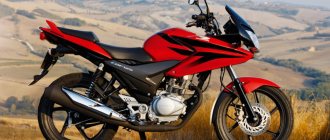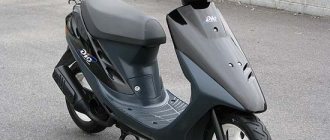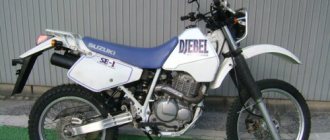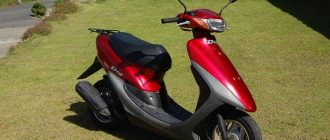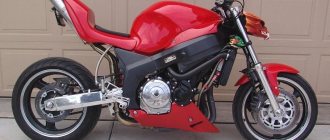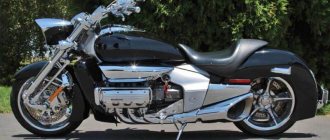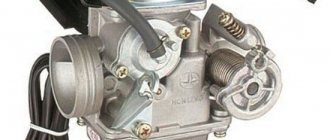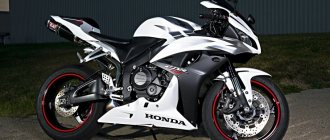RU-MOTO rating
- Reliability
- Chassis
- Appearance
- Comfort
4
Verdict
Overall, the Honda XR250 is one of the best in its class. With a small engine capacity, the motorcycle is considered playful, and the rigidity of the design makes it easy to control the bike not only for experienced users, but also for beginners.
Sales of the Honda XR250 started in 1985 and ended in 2007. The accumulated experience in motorsports, reviews of experienced amateurs and expert opinions fully reveal the capabilities of the legendary motorcycle.
The foundation of the 250 series was laid 30 years ago, and the first production of motorcycles was intended for the domestic market. Over time, the Japanese company released modifications of the model, which were already positioned not only for enduro (sports discipline), but also for off-road enthusiasts. Since 1995, Honda has offered the market:
Read other motorcycle reviews Aprilia RS 50 review: one of the best in the “pseudo-bike” category or not?
- A lightweight version for the European and American markets of the Honda XR250 R;
- For internal use, modification of the Honda XR250 Baja;
- Honda XR250 Motard (modification 2003).
Honda XR250 Baja
In the Baja model, the manufacturer installed a double headlight, an electronic speedometer and increased the capacity of the fuel tank. The R version was positioned as a lightweight enduro and did not have any special differences from the basic configuration. The biggest changes were made to the XR250 series with the introduction of the Motard model. It was equipped with road wheels, reinforced suspension and brakes.
Honda XR 250 Motard
Price
Currently, only the Honda XR250 Baja and Honda XR250 R models, released after 1995, are offered on the used motorcycle market. A Honda XR250 Baja can be purchased without mileage in the CIS for 250,000 rubles, and a copy with the abbreviation R can be found from 100,000. The Motard model is offered from 175,000 rubles. New motorcycles of this series are not offered for sale on the domestic market.
Prices for Honda XR250 motorcycle
Read other motorcycle reviews of HONDA CBR1100XX – a fast motorcycle for brave people
Prices vary from 100 thousand to 240 thousand rubles. The average price is 180 thousand.
Checks without expiration date
The increase in technology of currently produced motorcycles is not always directly related to the quality and quantity of pleasure received while driving. A lot and expensive are not always good and interesting. The downside of electronic assistants, security systems, and ultra-light materials is an increase in the number of possible breakdowns and, as a result, increased repair and operating costs.
The palm among unbreakable motorcycles was confidently occupied by Japanese technology. Statistics are a stubborn thing! But here too there are leaders and outsiders. The glory of perpetual mechanisms, a kind of AK-47 among motorcycles, categorically belongs to the light enduro class of 250 cm3. The laurels of the strongest and most “useful” check of all times rightfully belong to the Honda XR250. The most popular off-road modifications are the XR250R and XR250 Baja. The models are three hundred years old, they have not been produced for a long time, but lovers of extreme long-distance tourism and just fans of tinkering in waist-deep mud cannot imagine their lives without these rogues.
Among all the possible representatives of the XR250 family, which have been produced for 35 years, we will take a detailed look at only the 1995–2007 models that have become particularly popular in Russia. Due to their venerable age and some archaic primitiveness, early modifications are almost impossible to find on the open market. More modern representatives of the family moved to the CRF subgroup and at the same time got bogged down in marketing, and also significantly lost valuable consumer qualities and popularity.
Background
The first appearance of 250 cc enduros in the Honda lineup in the form in which we are accustomed to seeing them actually happened back in 1981. Archaic by modern standards, the enduro Honda XL250R, equipped with a single-barrel engine from the even more ancient Honda XL250S, existed until 1983. Then in 1984 the XLX250R (XR250R for America) appeared with a new engine in which the four-valve head was made using the RFVC (Radial Four) system Valve Chamber). Radial valves are driven by a single camshaft through rocker arms, which has the best effect on the compactness of the combustion chamber. The next round of history is the release of the Honda XLR250R enduro in 1985. In it, the engine with RFVC, largely due to changing the cylinder dimension from 75x56.5 mm to 73x59.5 mm, received more power, torque and reliability. The first public fittings of the image rally replica Baja took place back in 1987 with the advent of the Honda XLR250 Baja.
Honda
XR 250 (1995–2007)
The modern history of the legendary lightweight enduro Honda XR250 begins in 1995, when the Honda XR250 and Honda XR250 Baja models entered mass production. Over the course of time, the chekushki developed in parallel with the 400 cc XRs. The base model is the Honda XR250. This is a classic lightweight enduro for the domestic Japanese market. A steel frame made of rectangular cross-section pipes houses a single-cylinder air-cooled engine with a dry sump lubrication system (oil tank in the frame, double-chamber gear pump in the crankcase), an automatic decompressor, the same RFVC radial valve system and a six-speed gearbox. When moving from the XLR family to the XR 250, the engine parted with the kickstarter (except for the XR250R) and progressive grease fittings, changed the lubrication system from a wet sump to a dry sump, and received an electric starter and battery. The birth of the confrontation between convenience and resource!
The chassis is a kind of compromise. At the front there is a simple telescope with a pipe diameter of 41 mm, at the rear there is a monoshock absorber with progressive links. Suspension travel on the XR250 is 300mm front, 220mm rear.
Throughout production, the Honda XR250 family was gradually modernized. For the American market (model XR250R), fundamental innovations were introduced a year late. In 2000, in addition to the basic modification, the XR250 version appeared with plastic “burdocks” around the tank. Since 2003, this configuration has been the only one possible. Until 1997, the domestic Japanese XR250 and XR250 Baja did not have any catalysts or other environmental protections. Since 1998, they have appeared in standard equipment. In 2003, a serious set of upgrades fell (the so-called XR250-2). Firstly, the appearance has changed. This is noticeable in the more expressive plastic above the headlight, the plastic around the tank, the straight tail and the CRF-style front fender. Secondly, the long-awaited changes to the suspension and engine have arrived. The simple telescope is retained by the Baja and XR250R. Honda XR250 and XR250 SM got a 43-mm “upside-down” one. The firmware in the electronic engine control unit has been optimized for better control and greater performance at low speeds. In the period from 2006 to 2007, changes were introduced to the carburetor (another main jet) and appearance (the rear sides, headlight and fairing around it changed).
Honda
XR 250 R (1996–2005)
Honda XR250R is a hard enduro without the ability to go on asphalt. Sold exclusively in America and Europe, it appeared a year later than the domestic Japanese versions. The factory version of the lighting equipment includes only a headlight and a taillight. There are no direction indicators. Standard toothy tires 120/70–17 and 160/60–17 are a purely off-road attribute.
The Honda XR250R has a number of fundamental differences from the “civilian” modifications: sharper camshafts, an increased compression ratio, the absence of an electric starter (kick only), the absence of passenger footpegs, a minimalist dashboard, a 41 mm fork with travel reduced to 260 mm and a full set adjustments, fully adjustable monoshock absorber with travel reduced to 220 mm, dry weight 116 kg, fuel tank 9.7 l. There is a fairly rare batch of motorcycles equipped with flat-choke carburetors with an accelerator pump. Production of the Honda XR250R ceased in 2004; motorcycles were sold until 2005.
Honda
XR 250 Baja (1995–2004)
The most common version of the Honda XR250 in Russia is the Baja. It is also in the Russified version “Baya” or “Badzha”, although the most appropriate and pleasant-sounding version is the adapted version of “Bach”. Baja is a Spanish word. In the original version it is read exactly as “baha”. Geographically, Baja is an area in southern California where the first short rally raid was held.
Eccentric goggle-eyedness is not at all a whim of designers. In fact, the motorcycle is based on the race of the same name. In a nutshell, Baja is one of the toughest rally marathons around. Sand, poor visibility, difficult navigation... At one time, riders on Honda XR600R motorcycles, equipped with dual round headlights for better navigation at night, performed brilliantly in Baja. The Japanese even produced the Honda Dio scooter and the Honda Monkey moped in the Baja style.
Honda XR250 Baja is a motorcycle strictly for the Japanese domestic market. It came to us in large quantities along with the first wave of second-hand goods and took root very well. The Baja modification differs from the basic XR250 in optics, a seat (1.5 cm wider), engine settings, a gas tank increased to 14 liters (from 1996–1997), an electronic instrument panel with an on-board computer like the Africa Twin, and suspensions with increased travel. (300 mm each at the rear and front), increased fork offset and steering column angle. The frames of the Baja and the regular Xer are the same. The Honda XR250 Baja was discontinued in 2004.
Honda
XR 250 SM (2003–2007)
In 2003, the model range was supplemented by a factory motard – the Honda XR 250 Motard. The device is almost mythical! Unlike the XR400SM, almost no one has seen it live in Russia. Still, 249 cm3 and 28 liters. With. at the peak it’s not enough for a motard.
The SM version is no different from other XRs in terms of engine, frame and attachments. The fundamental difference is observed in the suspension, brakes and appearance. Instead of a puny telescopic fork, the motard, as expected, is immediately armed with a “shifter”. In this particular case, it is an adjustable Showa fork with a tube diameter of 43 mm and a stroke of 240 mm. A single brake disc with a diameter increased to 260 mm is attached to the left feather. The calipers are unified with off-road versions. In the rear suspension, the motard still has the same monoshock absorber and progression links as the XR250R. The tire size is more asphalt - 110/70–17 and 130/70–17. The dry weight of the motorcycle is 120 kg, the seat height is reduced to 855 mm, there are slight differences in dimensions. The appearance has been adjusted from a distinctly off-road look to a more asphalt look due to the “bugs” on the tank and road tires.
Crash tests
Honda XR250 model 1995–2007 and earlier years of production is not afraid to fall! If fatal breakdowns occur that immobilize the motorcycle forever, then only in serious accidents and at high speed. In other cases, the controls break or bend (levers on the steering wheel, the steering wheel itself, brake pads and gearbox). With frequent driving on serious off-road conditions, the plastic traps break off quite quickly. Aftermarket aluminum parts solve the problem.
The Honda XR250 Baja is a special case. The monumental design with two headlights and a yoke for those who like to lie around is a potential source of increased problems. Sooner or later, after a series of vigorous falls, the metal bracket breaks. As a result, the headlights hang helplessly on the wires. The enlarged gas tank has a similar fate. It's big and wide. It gets scratched or wrinkled every time it falls on its side.
When purchasing a Baja, look carefully at the yoke and bracket. It’s difficult to brew everything the way they do it at the factory. A large number of seams, misalignment and other collective farm problems are evidence of the difficult fate of the motorcycle. Grandmothers don’t go shopping for bread like that!
Technical features
Representatives of the Honda XR250 family are usually called the eternal motorcycle. In this case, eternity should not be understood very literally. Any motorcycle breaks down, there are no mechanisms that do not wear out. The beauty of the XR250 is its amazing durability. This equipment was created specifically for harsh working conditions, hence the set of certain qualities and a fantastic margin of safety, allowing operation to be interrupted only for extremely rare maintenance. It can be disabled only by seriously damaging the frame and number plates. Everything else is being fixed. Fortunately, there are very few parts in the motorcycle, they are reasonably priced and have high unification within the model line.
The Honda XR250 of the 1995–2007 model definitely has no weak points that should be given increased attention. The main enemy of this technology is age, untimely and unqualified maintenance. Thanks to the increased safety margin of the chassis and the low degree of engine boost, the motorcycle, even in the most advanced cases, will creak, rattle, but still ride. Of course, you should not abuse it. If you frequently travel off-road, you should regularly inspect the suspension elements. Particular attention to wheel bearings and progression rods. Their main enemy is sand and the lack of grease nipples. A complete inspection with lubrication and replacement of worn parts must be carried out at least once a season.
During normal quiet driving, the engine will only ask for a replacement of spark plugs, filters and oil. Servicing the Honda XR250 does not pose any particular problems even for beginners. All procedures are obvious and understandable. The fastener is large and strong and does not fall apart in your hands. The valves are regulated by a simple screw-nut system. The adjustment interval is once a season. It is important to once and for all become familiar with the dry sump lubrication system and the frame as an oil tank. To check the level, place the motorcycle upright, then start the engine for five minutes. Then turn off the engine and immediately check the oil level. It is important not to overdo it with the amount of oil poured! Otherwise, it will be squeezed out through the breather or, if you are very unlucky, through the seals in the engine.
An acceptable oil change interval is once every 2000–5000 km, depending on the nature of operation. The Honda XR250R requires more frequent and meticulous maintenance (especially oil changes and air filter cleaning), since it is essentially a sports equipment. The engines of all XRs do not like long-term driving at high speeds, like all single-barrel engines. There is a problem associated with the filter mesh in the oil tank frame. This mesh must be periodically checked and cleaned, otherwise in particularly advanced cases a drop in pressure in the system may occur and, as a result, oil starvation. In case of oil starvation caused by loss of pressure or insufficient oil level in the system (which is often the same thing), in addition to CPG parts, the camshaft and rockers are likely to become victims of wear.
In case of active off-road use, once a season it will not be superfluous to look into the details of the CPG. If the situation is favorable, for further trouble-free driving you may only need to replace the piston rings. If unfavorable - the piston, cylinder, valves, timing chain along with the tensioner, and then not far from the crankshaft with main bearings. The XR250 power unit uses rolling bearings, which has the most favorable effect on service life. If you monitor the oil level, even your grandchildren will not know what an engine overhaul is. Possible sources of increased oil loss are hardened valve stem seals or worn piston rings.
You can often hear criticism from Honda XR250 owners about the not very comfortable seat and especially its passenger part. By and large, the XR250, like many other similar “checks”, is a motorcycle for an egoist. Riding together will significantly spoil the dynamics and pleasure of the trip, and also, importantly, significantly reduce the service life of engine and suspension parts.
Tuning Honda chekushek is not radical in nature. The XR250 SM is being completed for stunt and track, pumping the brakes and engine. The XR250, XR250R and Baja are being modified for long-distance touring. And the main thing here is not to overdo it with the amount of luggage in the back of the motorcycle. The subframe is quite strong, but everything has its limit. Prolonged rides with overload will most likely kill the rear shock absorber.
The general unification of parts within the family is very helpful. Thus, the Baja tank is very popular among truckers, and the fork, shock absorber and wheels from a supermotard are very popular among street shooters. There is a special kit in nature that allows you to install a kickstarter on any XR250.
Conclusion
The Honda XR250 is a very profitable, even anti-crisis, motorcycle. It is inexpensive, hassle-free maintenance and major repairs, and is easy to use. A really good example of how you can experience all the joys of riding a “proper” motorcycle for little money, without resorting to newfangled electronics and other gadgets.
Low unit costs are primarily a consequence of the simplicity of the design and venerable age, which in no case excludes interesting and versatile functionality.
The Honda XR250 family hasn't had its last word yet! Teenage > April 26, 2016 13:19 Mikhail Pimus
Specifications
- Engine capacity – 249 cm3. (equipped with 4-valve head with RFVC system);
- Lubrication system – “dry sump”, with the oil tank located inside the frame;
- Power – 28 l. With.;
- Torque – 26 Nm at 7000 rpm;
- Cooling – air;
- Fuel system – carburetor;
- Gearbox – 6-speed;
- Maximum speed – 120 km/h for the Baja model and 125 km/h for the R and Motard versions;
- Average fuel consumption is 4 liters. per 100 km.
| Year of issue | 2003-present |
| Width x Length x Height (m) | 2.175×0.805×1.190 |
| Wheelbase (m.) | 1.425 |
| Minimum ground clearance (m.) | 0.285 |
| All technical specifications are here. | |
Advantages and disadvantages
The main advantage of the Honda XR 250 motorcycle is that it can be used for motorcycle touring in extreme conditions. As a matter of fact, it was designed for these purposes. Achieving optimal layout and balance is ensured by the following characteristics of the motorcycle:
- Long travel suspensions.
- Ease.
- Excellent quality even after forty thousand kilometers in Japan.
- Availability of lighting equipment and trip computer.
- Unsurpassed maneuverability, which is achieved through a well-thought-out design. The presence of a short base and a sharply installed fork.
- Good traction at the bottom.
- Wide range of engine capabilities, combined cooling.
- Ideal oil supply system. Moreover, in extreme cases, low-quality oil can be poured.
- Possibility of deep tuning.
Such characteristics of the motorcycle allow it to overcome significant heights and fit into the tightest turns.
Among its analogues, the Honda XR 250 is considered the most popular motorcycle because of its undeniable advantages: reliability, lightness, cross-country ability. It was on this enduro that an athlete from Hungary set a world record (still unsurpassed) when conquering a height of 6183 meters in the Himalayas.
Honda's disadvantages include:
- Small headlights. If you need good light, then it is better to choose the Honda XR 250 Baja model with additional large headlights.
- Use of original spare parts in repairs.
- High price.
- The electric starter can become sour when the car is idle for a long time.
- When used in harsh conditions, clutch discs wear out quickly.
- Slow acceleration.
- Suitable for solo riding only.
- No wind protection.
- Not suitable for short people.
Owner reviews
Screenshot of review No. 1.
Screenshot of review No. 2.
Screenshot of review No. 3.
Repair Honda XR 250
If any element of the motorcycle fails, replacement should only be made with an original spare part.
If the engine malfunctions, drivers recommend not changing it completely, but replacing those parts that have failed. It may not be cheaper, but it’s definitely more reliable. Operating experience shows that with timely oil changes (every 2000-5000 km), the engine will last for a very long time without repair.
When using enduro on rough terrain, special attention should be paid to suspension elements, wheel bearings and progression links.
Operation in non-aggressive conditions requires replacing spark plugs, filters and oil once a season.
All fastenings are strong, large and do not raise any questions during repairs even for beginners. The valves require adjustment once a quarter.
Timely diagnosis and replacement of faulty Honda parts will lead to long-term operation of the motorcycle without breakdowns or accidents.
The Honda XR250 is an excellent, and most importantly, reliable and high-quality choice for both beginners and professionals.
Competitors
The main competitors of the Honda XR250 are motorcycles from Kawasaki model KLR250, Suzuki DR250, Yamaha TT-R250 Open Enduro, Yamaha TT-R250 Raid and Suzuki Djebel 250.
Kawasaki KLR250
Yamaha TT-R250
Suzuki Djebel 250
Read other motorcycle reviews of the BMW S1000 RR: detailed review
Tuning
Tuning of Honda XR 250 motorcycles is most often used to improve performance and increase service life for off-road riding. To improve a motorcycle, they most often turn to specialists. The most used tuning elements:
- arcs and slides - to improve the strength of the structure, they are installed by welding;
- brakes made of composite materials to improve their sensitivity.
Appearance is also an important tuning detail. Various elements are used to decorate a motorcycle:
- front fender extension;
- side stand stands;
- protection of hands and control levers;
- protection of telescopic fork stays;
- protective anthers;
- steering wheel cuffs;
- universal palm-mounted cruise control;
- heated covers and grips;
- LED turn signals and adapters for them;
- mirror expanders;
- platforms for wardrobe trunks.
The design of the motorcycle can also be chosen to suit every taste. Airbrushing is very popular.
Chassis and brakes
The frame of the XR 250 is made of steel. In appearance, this is a typical motard, somewhat reminiscent of a motocross motorcycle. The wheels are spoked. Since the landing is quite upright, the steering wheel is appropriately wide. This is generally a characteristic feature of the class.
The rear suspension travel of the XR 250 is 220 mm. This is a progressive monoshock. At the front, the suspension with a travel of 240 mm is an inverted fork with dimensions of 43 mm. The rear brakes are a single 220 mm disc, assisted by a single-piston caliper. The front brake is also served by a single disc, but its size is 260 mm, and it is supported by a two-piston caliper.
